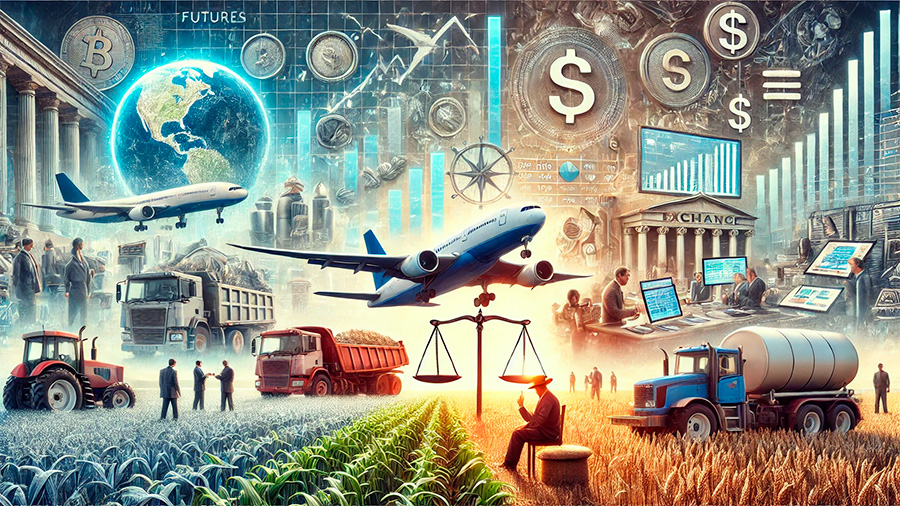Futures play a pivotal role in shaping the global economy by providing a mechanism for price discovery, risk management, and market efficiency. These financial instruments allow participants to hedge against price fluctuations, speculate on market movements, and stabilize global trade. With their influence extending to commodities, currencies, and indices, futures trading has become a cornerstone of economic activity worldwide. Understanding how futures impact pricing, economic stability, and market dynamics offers valuable insight into their significance in the modern economy.
How Futures Facilitate Price Discovery
Futures contracts are central to determining prices in global markets. By aligning the expectations of buyers and sellers, they provide transparency and predictability in pricing. Through the futures market, participants assess supply and demand dynamics for underlying assets, creating a benchmark price that reflects market sentiment.
For example, in the commodities market, futures trading determines the price of essential goods like oil, wheat, and gold. Producers and buyers negotiate contracts based on projected supply shortages, geopolitical events, or seasonal trends. This dynamic pricing mechanism enables businesses to plan operations and investments with greater confidence.
Moreover, futures markets operate almost around the clock, ensuring a continuous flow of information. This accessibility enhances price discovery by incorporating real-time developments, such as economic reports or geopolitical shifts, into market valuations.
Global Commodities and Their Impact
- Oil futures influence transportation and energy costs worldwide.
- Agricultural futures impact food pricing and global supply chains.
- Metals futures shape the cost of industrial production and construction.
Through these connections, futures markets ensure that prices are responsive to both local and international factors, fostering a more integrated global economy.

Managing Risk Through Futures Contracts
Futures provide a critical risk management tool for businesses and investors. By locking in prices for future transactions, participants hedge against adverse price movements, protecting themselves from market volatility. This predictability is particularly beneficial in industries exposed to fluctuating commodity prices or exchange rates.
For instance, an airline might use oil futures to stabilize fuel costs, while a farmer might hedge against declining crop prices through agricultural futures. Similarly, multinational corporations leverage currency futures to mitigate the risks associated with exchange rate fluctuations. This proactive approach to managing uncertainty enables businesses to maintain profitability and plan for the long term.
Hedging through futures is not limited to corporations. Governments and central banks also engage in futures trading to safeguard national economies. By stabilizing prices in critical sectors, they prevent economic shocks and ensure steady growth.
Key Benefits of Hedging
- Minimizes exposure to price volatility.
- Ensures stable cash flow for businesses.
- Supports strategic financial planning and investment.
Hedging through futures allows participants to focus on core activities without the constant worry of market disruptions.
The Role of Futures in Market Efficiency
Futures markets enhance overall economic efficiency by providing liquidity and enabling swift transactions. Their standardized nature ensures that contracts are easily tradable, reducing friction in financial markets. High levels of participation in futures trading also contribute to tighter bid-ask spreads, fostering competitive pricing.
Arbitrageurs play a vital role in maintaining market efficiency. By exploiting price discrepancies between spot and futures markets, they ensure that prices converge, reflecting the true value of the underlying asset. This activity not only improves market accuracy but also discourages speculative bubbles and manipulative practices.
Additionally, the futures market supports global trade by facilitating currency exchange and commodity delivery. Exporters and importers rely on futures contracts to stabilize costs, ensuring predictable revenue and expenditure across borders.
Liquidity and Accessibility
Futures markets are characterized by high liquidity, enabling participants to enter and exit positions seamlessly. This accessibility reduces transaction costs and attracts diverse participants, from institutional investors to individual traders. As a result, markets remain active, efficient, and resilient against shocks.

Futures and Economic Stability
Beyond individual markets, futures play a crucial role in maintaining economic stability. By offering a mechanism for mitigating risk and stabilizing prices, they protect economies from abrupt changes in key sectors. Futures also serve as a barometer of economic health, with price trends reflecting broader economic conditions.
During periods of economic uncertainty, futures markets often act as a refuge for investors. Safe-haven assets like gold see increased futures activity, while currency futures help stabilize exchange rates. This behavior underscores the interdependence between futures markets and the broader economy.
Furthermore, the regulatory oversight of futures markets enhances their role in maintaining stability. Stringent margin requirements, position limits, and reporting obligations ensure transparency and prevent systemic risks. These safeguards reinforce trust in futures as a reliable tool for managing economic volatility.
Indicators of Market Confidence
- Rising activity in equity futures signals optimism about economic growth.
- Increased participation in commodity futures reflects concerns about inflation or supply chain disruptions.
- Fluctuations in interest rate futures indicate changes in monetary policy expectations.
By monitoring futures trends, policymakers and businesses gain valuable insights into market dynamics and economic outlooks.
The Challenges of Futures Trading
While futures offer significant advantages, they also come with inherent challenges. The complexity of these financial instruments requires participants to have a deep understanding of market dynamics. Without adequate knowledge, traders risk significant losses due to leverage and market volatility.
Moreover, the speculative nature of futures markets can lead to rapid price swings, impacting businesses that rely on stable pricing. Excessive speculation may also distort market fundamentals, creating artificial demand or supply imbalances.
Finally, access to futures markets is not evenly distributed. While large institutions dominate trading volumes, smaller businesses and individual investors often face barriers due to high costs or limited expertise. Addressing these disparities is crucial for ensuring that futures markets remain inclusive and equitable.
Mitigating Risks in Futures Trading
- Invest in comprehensive market education and training.
- Utilize risk management tools like stop-loss orders.
- Work with experienced brokers or financial advisors.
By adopting these strategies, participants can navigate the complexities of futures trading with confidence and precision.
Conclusion
Futures play an indispensable role in the global economy by facilitating price discovery, enabling risk management, and enhancing market efficiency. Their influence extends across industries, impacting everything from commodity prices to monetary policy. While challenges exist, the benefits of futures trading far outweigh its risks when approached with the right knowledge and strategy. As markets continue to evolve, futures will remain a cornerstone of global economic activity, shaping the future of trade and investment worldwide.



